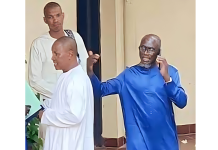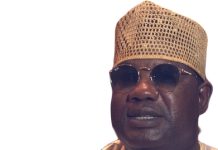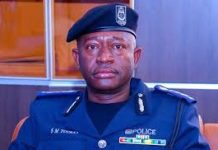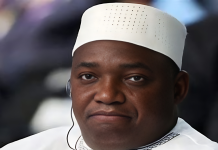By Kemeseng Sanneh (Kexx)
The two defendants are facing murder charges in connection with the shooting of police officers.
Ousainou Bojang is charged with murder and terrorist attack. He is accused of causing the death of two police officers and injuring one, while Amie Bojang is charged with accessory after the fact to murder. She’s alleged to have aided or abetted Ousainou Bojang after a shooting incident occurred in Sukuta/Jabang Traffic Light.
The case proceeded with cross-examination of the first state witness Ismaila Bojang (soldier) by lawyer Lamin J. Darboe for the first accused (Ousainou Bojang).
When the case was called, ER, Dunga F. Faye and C.C Jobarteh appeared for the state, while Lamin J. Darboe represented the first accused and Lamin Mboge & H. Farage represented the second accused.
Counsel J. Darboe asked the witness, “Have you made a statement to the police?” The witness replied, “Yes.”
“When did you make the statement?” Counsel Darboe inquired.
“It was on the 14th of September,” the witness answered.
Counsel Darboe then asked, “If you see the statement, can you recognize it?”
“Yes, I can,” the witness replied.
“How can you recognize it?” Counsel Darboe inquired further.
“What I said on that day, if I see it, I will recognize it,” the witness explained.
“Did you sign it?” Counsel Darboe asked.
“Yes, I signed it, and it has my name,” the witness confirmed.
Counsel J. Darboe then showed the document to the witness and asked whether that was a copy of the statement. After going through the document, the witness indicated to the court that it was indeed the statement.
Counsel Lamin J. Darboe asked whether the witness knew where the original copy was, and the witness said it was with the police.
Counsel Darboe applied for the state to produce the original copy of the statement.
Justice Jaiteh ruled that the state should produce the original copy of the witness’s statement.
Counsel for the state, Dunga, then informed the court that the original copy was with her and handed it over to the court. It was shown to the witness, and he confirmed that the document was the statement he made.
Counsel Lamin J. Darboe applied for the statement to be admitted in evidence as an exhibit, and there was no objection from the state counsel.
The statement was admitted and marked as D1.
“On that date, 12th September 2023, what time did you leave the barracks for training?” Counsel Darboe asked.
“I left the barracks in the early hours of the morning to work at the Army Barracks at Fajara. After finishing work around 15:00, I proceeded to the beach,” the witness replied.
“Where did you meet your colleagues, Mr. Jallow and Jarju?” Counsel Darboe inquired.
“At the Gambia Armed Force training school,” the witness responded.
“When did you leave the beach for Yundum barracks?” Counsel Darboe asked.
“After 7 p.m. or after Magrib prayers,” the witness answered.
“When you arrived at the Sukuta traffic light, do you recall the time?” Counsel Darboe asked.
“No, I don’t,” the witness replied.
“Do you know who gave you a lift to the traffic light?” Counsel Darboe inquired.
“No, I don’t know the person,” the witness answered.
“Where were you dropped off at the traffic light?” Counsel Darboe asked.
“Opposite the petrol station,” the witness replied.
“Do you know the name of the petrol station?” Counsel Darboe asked.
“I don’t know,” the witness replied.
“You said you crossed the road. Where did you cross, and where did you go?” Counsel inquired.
“We crossed the road towards Jabang direction,” the witness explained.
“When you crossed the road, where did you go?” Counsel Darboe asked.
“I was standing near a building around the road, facing Jabang,” the witness replied.
“At that point, what was the distance between you and the police officers?” Counsel Darboe asked.
“I can’t give an accurate measurement of the distance,” the witness replied.
“You said you were behind the officers?” Counsel Darboe confirmed.
“Yes,” the witness answered.
“Do you know how far you were from the officers?” Counsel Darboe asked.
“I can’t tell,” the witness replied.
“Do you recall the location of the first officer who fell on the ground with his AK47?” Counsel Darboe inquired.
“At the same spot on the other side of the road,” the witness answered.
“What side of the road? Because I think you are on the side,” Counsel Darboe asked for clarification.
“The road is divided into two, and I was standing on the Sukuta side while officers were on the Jabang side,” the witness explained.
“Apart from your colleagues, are you aware of any other person who witnessed the incident?” Counsel Darboe asked.
“People were many there,” the witness replied.
“Where were you when the female officer was shot?” Counsel Darboe inquired.
“Before the female was shot, I decided to intervene,” the witness replied.
“So, why couldn’t you prevent the female from being shot?” Counsel Darboe asked.
“Yes, because the distance was far and I knew that he possessed a firearm,” the witness explained.
“But that did not prevent you from pursuing the shooter,” Counsel J Darboe asked.
“Yes, it didn’t,” the witness replied.
“You say the distance is far. Can you tell the court how far the distance was?” counsel Darboe inquired.
“I can’t tell,” the witness replied.
“When the gunman showed up, did you do anything?” Counsel Darboe asked.
“No, but the second officer was scrambling with the gunman,” the witness said.
“Which direction did the gunman run away, and did he come towards the petrol station?” Counsel Darboe asked.
“He ran towards Sukuta,” the witness explained.
“You said he entered the first junction on the road to Sukuta, and you followed him into that street according to your testimony. Is that correct?” Counsel Darboe asked.
“Yes,” the witness answered.
“At this stage, how many of you were following the gunman?” Counsel Darboe inquired.
“I can’t tell,” the witness replied.
“Are you the only one following the gunman?” Counsel Darboe pressed further.
“No,” the witness replied.
“Then it was you and who and who and who?” Counsel Darboe asked.
“I know of Bakary Jarju, and Omar S. Jallow is the one I personally know,” the witness answered.
“What happened to your training when three military officers couldn’t apprehend a bowlegged man?” Counsel Darboe inquired.
“Because we were pursuing an armed man,” the witness explained.
“Then you were wrong to pursue the shooter,” Counsel Darboe stated.
“We took safety measures,” the witness replied.
“You said he fired his gun twice while you were chasing him. So, what safety precautions did you put in place?” Counsel Darboe asked.
“We left a distance between me and the shooter, went away from the possible direction of the fire, and looked for cover,” the witness replied.
“I’m putting it to you that in that street, there is no possible fire cover,” Counsel Darboe challenged.
“Yes, there is,” the witness insisted.
“Can you give an example of possible fire cover?” Counsel Darboe asked.
“Concrete poles, fences, etc.,” the witness replied.
“Where on that road was a concrete pole erected?” Counsel Darboe asked.
“At the first junction in the street,” the witness clarified.
“What distance did you leave between yourself and the gunman?” Counsel Darboe inquired.
“I can’t tell,” the witness replied.
“I put it to you that you made up the story because you never entered that street,” Counsel Darboe challenged.
“No, I entered,” the witness asserted.
“So how far had you gone in that street while pursuing the shooter?” Counsel Darboe asked.
“Very far,” the witness replied.
“All along with Mr. Jarju and Jallow?” Counsel Darboe asked.
“Yes, they were behind me. But I noticed it was Bakary who was next to me when I lost sight of him,” the witness clarified.
“Who?” counsel Lamin J. Darboe asked the witness.
“The shooter,” the witness replied.
“Do you know the person the shooter spoke to for 2 to 3 seconds, as per the evidence-in-chief?” Counsel Darboe inquired.
The witness answered, “No.”
“Can you describe the distance?” Counsel Darboe asked.
“Almost 400 meters,” the witness replied.
“And in the end, it was a futile pursuit?” Counsel Darboe asked.
“Yes,” the witness admitted.
“You said you collected two empty gun casings,” Counsel Darboe stated.
“I recovered one, and Bakary recovered one, and we handed over both to the police,” the witness replied.
“Do you know the particular police officer?” Counsel Darboe asked.
“No, I don’t know him,” the witness replied.
“And you picked up the empty gun casings with an empty hand?” Counsel Darboe clarified.
“Yes,” the witness confirmed.
“Were you not aware that this is a trial scene?” Counsel Darboe inquired.
“Yes, I was aware, but the crowd had already encroached on the place,” the witness explained.
“When you arrived at the scene, did you see any police officers?” Counsel Darboe asked.
“Yes, I saw police officers who were on traffic control,” the witness replied.
“Where were the officers who were shot?” Counsel Darboe inquired.
“I don’t know, but I know they were taken for medical treatment,” the witness replied.
“Do you recall the time you returned to the crime scene?” Counsel Darboe asked.
“It was about 21:23,” the witness replied.
“So, how long did it take you to follow the shooters and return to the crime scene?”Counsel Darboe questioned.
“I can’t tell,” the witness replied.
At this point, counsel J. Darboe requested the witness’s statement and asked him to read from Omar. The witness read until he mentioned that at 21:12, the shooter fired the gun.
Counsel J. Jobarteh asked the witness to stop reading at that point and told the witness that 21:12 was the time he pursued the shooter for 400 meters and returned to the scene in only 12 minutes.
“Yes, it is possible because we are trained in BFT, which allows us to run 800 to 900 meters in 9 minutes,” the witness explained.
The counsel for the second accused Amie had no questions for the witness, and the witness was discharged.
The second witness of the state Bakary R. Jarju began his testimony in the case. The witness, Bakary R. Jarju, said he’s a member of the Gambia Armed Forces (GAF) attached to the GAF training school and is resident in New Yundum.
During questioning by state Counsel Dunga, Jarju confirmed that an incident occurred on September 12, 2023. When asked to provide details, he recounted that he, along with Ismaila Bojang and Omar Jallow, went for training at Senegambia beach.
He testified that the purpose of the training was their selection for special training to be held in Turkey.
After their training session, while returning home around Maghrib prayers, they got a lift and were dropped at Sukuta Traffic Light Junction and they decided to buy dinner (Afra). Jarju (the witness) explained that they crossed to the other side of the road, which was divided in two, and stood on a veranda behind three police officers. One officer had an AK-47 rifle and was seated in the center.
Witness Jarju said he heard a gunshot and immediately turned to the direction of the shot. He saw the officer with the AK-47 down, adding that he assumed it was a negligent discharge.
He further testified that another officer who was seated on the left side stood up, and a struggle ensued between him and the shooter. Witness Jarju said that was the time he realized the situation was not normal and the shooter fired a shot at the officers.
He (the witness) testified that the shooter then took a step back and shot the female officer before fleeing to the Sukuta Traffic Lights roundabout.
He said as people gathered there, the shooter fired more shots, this time and that was the time he (Jarju), was able to distinguish the sounds of weapons due to his military training and recognized the type of weapon from the sound as pistol.
He revealed that along with Ismaila Bojang and Omar Jallow, he pursued the shooter. During the chase, the shooter fired a shot but he couldn’t determine its target. He alerted Bojang to take cover when the shooter turned and fired again. They decided to take cover behind a fence, anticipating potential danger from someone armed with a pistol at close range.
While continuing the pursuit, the shooter entered an incomplete building in a dark area without electricity, adding that he (witness) proposed using the fence as cover, but Bojang suggested that they follow the shooter instead.
He said he (Jarju) emphasized the risks of entering an unfamiliar territory, poorly lit area without weapons and advised Bojang for them to return to the scene to gather evidence which Bojang agreed.
He testified upon arrival using his phone torch lights with Bojang, they searched the area and discovered two empty bullet casings. He said he identified the casings as “live rounds” that had been fired, as the bullets were missing.
He further testified that an officer named Sowe approached them during this search, initially unidentified as a police officer. Eventually, Sowe revealed himself as a CID officer, and Jarju apologized for not recognizing his status earlier.
Sowe asked to speak with him and Sowe suggested moving to his white pick-up truck for privacy. There, he requested water to drink which Sowe provided and he explained to Sowe that they had come from Senegambia and heard gunshots and saw a man who was the shooter and pursuit him, but they could not apprehend him.
The witness (Jarju) said he handed over the empty bullet casings to Jallow his colleague, who then handed them to Officer Sowe.
When asked to describe the shooter’s appearance, the witness (Jarju) describe that he’s tall but couldn’t accurately describe his cloth color but is a haftan, he said the shooter is slim and wore ankle-high covered shoes.
The witness (Jarju) highlighted that his primary focus was on identifying the shooter’s weapon, but despite it being nighttime, he could identify the weapon as pistol because the distance was approximately 20 to 25 meters away, allowing him to observe it clearly.
He finished his testimony and he is expected to be cross-examined by Counsel Lamin J. Darboe on Monday.


















